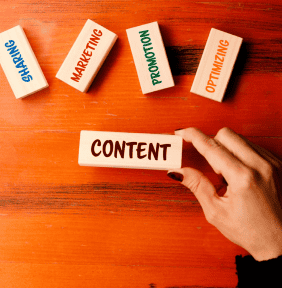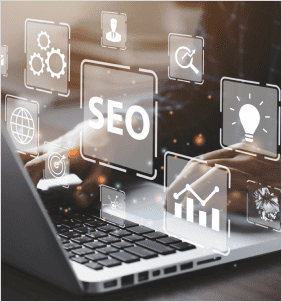Which is really better? Assuming you’re not going to do both, should you invest in SEO to grow organic traffic; or should you pay-as-you-go and buy your traffic with Search Ads?
The easy option for me would be do a nice little analysis of the pros and cons of each and then conclude “well, SEO is better in this situation; and SEM is better in that situation” but where’s the fun in that? This is a fist-fight! And, let’s be honest, who wants to see a fight where one fighter wins on left hooks and the other wins on upper-cuts but aww… everyone’s a winner at the end of the day. Deep-down, we want to see a violent and bloody knock-down don’t we? So, someone has to lose.
In the Red Corner… SEO
Free clicks
The most obvious advantage is that you’re not paying for each visitor to come to your website. Organic traffic is free – well, sort of. You might need to make a substantial investment in SEO to build that Position 1 organic ranking, but once you’re there in theory you’re getting [cue Dire Straits backing track] money for nothing and your clicks for free.
Better click-through rates
Another advantage of SEO is what’s known as the “trust factor”, meaning people are more likely to click on organic search results than on Ads. People are cynical and they tend to look at your Ads thinking things to themselves like “those guys are paying to advertise so they’re probably going to be more expensive because they have to recoup the cost of advertising” or “maybe they’re advertising because they’re not very well known – I mean they could have just setup in business yesterday – I really want someone who’s well know and trusted with a decent reputation” all in the blink of an eye as they decide which result to click on.
The stats show that click-through-rates (CTRs) for Organic results are (as of September 2018) 66% for Desktop search and 39% for Mobile search. For Paid results the CTRs are just 6% for Desktop and 9% for Mobile. Organic results get the lion’s share of traffic. If you’re wondering why the numbers don’t add up to 100% (e.g. for Desktop: 66% Organic + 6% Paid = 72%) that’s because there are “no-click searches” meaning that 28% of people didn’t click on any results at all.
Google has been gradually improving the CTRs of Paid results through such cunning ploys as changing the Ad icon to make it less obvious, so the Paid CTRs are better than they were, but still… Let’s assume that for your industry half your users search on desktop and half search on mobile: you could get 7 times the amount of traffic from ranking well organically than you will from running Ads. That’s quite a difference.
Sustainability
A third and not quite so obvious advantage of SEO versus SEM is that its more sustainable over the long term. Ads are like a tap: turn them on and you’ve got traffic, turn them off and you’ve got diddly squat (to use technical terminology). If you invest in building good ranking and the steady stream of organic traffic that flows from that, it will continue to flow unless your organic ranking drops dramatically across all keywords; which isn’t likely unless your website gets penalised by Google.
Also, if your doing things correctly, your rankings will gradually climb over the long term and, combined with search volumes also tending to grow over time, you will generally get progressively more and more returns from SEO each year. It’s an appreciating asset in other words. SEM Ads on the other hand are a depreciating asset; meaning the returns decline each year. This is because PPC is based on a keyword-bidding pricing model and, just like at a Sotheby’s auction, the price always goes up as the auction progresses rather than down.
Take a keyword like “emergency plumber Melbourne” for example:
in July 2016 the Avg CPC was $25/click whereas today it’s $61/click. So, if your Ads budget is $1,000/week, then you would have been getting 40 clicks a week two years ago whereas now you’d only be getting 16 clicks a week. Ergo depreciating returns. You can also get priced out of the game completely because, quite honestly, who can make money paying $61/click when you probably need at least 15 clicks to get one job? You’d have paid $900 to get that job from a Search Ad before you even got in the truck to drive out there.
And in the Blue Corner… SEM
Immediate results
The most obvious advantage of Ads is that they are instant. Set up your Ad campaign today and you get traffic today and, if you get it right, enquiries and sales today too. Granted you pay for that privilege, but you don’t have to wait the many months or even years that it takes to build a Page 1 organic ranking. SEO takes time. Not just because Google only crawls and discovers backlinks you’ve built and new content on your site every 4 weeks or so, but the whole ethos of good organic ranking is that, like reputation, it needs to have grown naturally over a period of time.
If you’re a new business in an industry with a lot of online competition and you’re planning to rely on SEO to bring in all your leads, then you’d better get a day-job for the first year or so. Search Ads might realistically be your only option. But even for established businesses SEM can offer a lot of advantages because of its immediacy – you can turn it up or down each week depending on what gaps you need to fill in your lead generation and you can’t do that with SEO.
More targeted
With organic traffic you are getting literally just anyone who searched your keyword and decided to click on you in search results. You can’t control who those people are other than by trying to target different keywords that you think are a better fit for your business. The visitors could be from another continent; they could be searching for something you don’t offer (but somehow you still ended up ranking for their search term); or they could be drunk at 3 o’clock in the morning. With Search Ads you can control these things and only show your ads to the people you want to bring to your website.
In SEM you can limit your geographical area very tightly to just your local suburb if you want to, or just to affluent suburbs you serve, or particular cities. You can exclude people from other regions and countries that you don’t want. You can also include negative keywords so that your Ad doesn’t show if someone includes certain words. For instance, if your goal is to get sales enquiries for your workflow software, then you can exclude people searching “free workflow software” and “workflow software jobs”. Further you can limit your Ads to show only on certain days or certain times of day to reduce the amount of irrelevant traffic. To an extent you can control your target audience by demographic factors too.
This is actually a major advantage. Organic results might have the potential to bring you 7 times the number of visitors but if 6 out of 7 are people you don’t really want (that you are just going to waste time following up but with no results) then you’d be better off just getting the one person to your website you wanted and not all 7.
Conversion optimisation
Taking it a step further, as well as controlling your audience, you can tweak your SEM campaign to get better conversion rates. You can experiment (in near real time) with different geographic areas, different keyword sets, different Ad headlines etc and work out which ones give you the best results; not just in terms of clicks but clicks that actually lead to conversions (such as enquiries, bookings or ecommerce sales). If one campaign or Ad group gets 8% conversion rates and the others only get 4% then you can channel more spend into the 8% Group to increase results further. Through ongoing optimisation, you can usually achieve much higher conversion rates from Ads.
More control over the message
With SEO your primary goal is always to do whatever is needed to get the best possible organic ranking and everything else becomes secondary. For instance, if your most popular keyword is “wooden table melbourne” then your page title (and therefore your headline in search results) plus the main heading on your website pretty much has to say “Wooden Table Melbourne” if you want the best ranking for that keyword.
With SEM your Ad headline could say “Affordable Wooden Tables – Free Delivery Across Melbourne” and the main heading on your website could say “Hand-Crafted Wooden Tables at Affordable Prices – Order Online with Free Delivery”. Those would likely deliver better click-through rates and better conversion rates than “Wooden Table Melbourne” which just repeats the main keyword but doesn’t contain any kind of Value Proposition.
And the winner is…
I have personally seen both SEO and SEM campaigns deliver amazing results when done well but the types of results are different. Businesses that invest significantly in SEO, and their SEO agencies that support them, tend to become obsessed with keyword ranking and website traffic levels, but what do these really mean on their own? In theory, good ranking leads to traffic, traffic leads to conversions, and conversions leads to sales. But it’s actually the sales that we really want. Business growth comes from acquiring more of the right type of customers and building better and longer customer relationships.
Therefore, I say that SEM is the winner because SEM brings us more closely to the business results we are actually looking for – sales. Yes, SEO can ultimately bring more traffic, and at a lower cost per visitor, but I would prefer to have one really good potential customer come to my website rather than 7 randoms.
If we just focus on ranking and traffic we lose sight of what really matters in good marketing. SEM allows us to control the target audience and most importantly the message. When I studied marketing (back in the late ‘80s) I learned that that there are 3 important variables in marketing communication: the Message, the Media, and the Audience. Controlling those things allows us to do great marketing and SEO does not allow us to control them. In fact, SEO and the obsession with keywords and ranking is responsible for giving us an entire internet of not-so-good websites with headings like Wooden Table Melbourne and a plethora of crappy blog posts about Features and Benefits of Wooden Table Melbourne. We’ve all seen them.
And, best of all, SEM is instant. We can turn it on and off whenever we want and turn it up if things are quieter, focusing on the results that we are looking for – leads and sales. That being said, the ultimate answer is that if you can, you actually need to do both! It’s the new real estate, and you need to own as much as you can!!!








